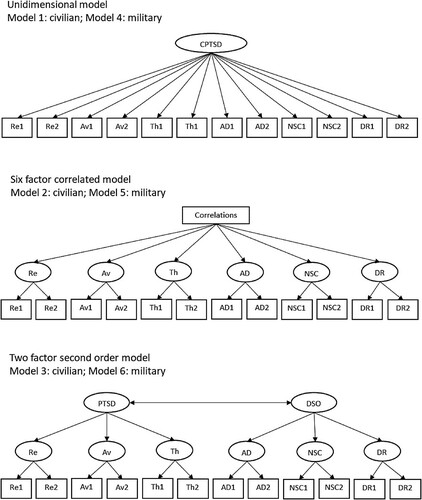Figures & data
Table 1. Demographics.
Table 2. Overall trauma exposure.
Figure 1. Alternative tested models of the latent structure of ICD-11 PTSD and CPTSD symptoms.
Note: PTSD = Posttraumatic Stress Disorder, DSO = Disturbances in Self-Organization, CPTSD = Complex Posttraumatic Stress Disorder, Re = Re-experiencing, Av = Avoidance, Th = Sense of current threat, AD = Affect dysregulation, NSC = Negative-self-concept, DR = Disturbed relationships.

Table 3. Endorsement of ITI symptoms and diagnostic rates.
Table 4. Model fit statistics for the alternative models of the International Trauma Interview.
Table 5. Partial correlation coefficients between ITI subscales and PCL subscales, BDI and BSI, controlling for age and gender: Civilian (above diagonal) and military participants (below diagonal).
Supplementary Table S2a and S2b factor loadings.docx
Download MS Word (18.3 KB)Supplementary Table S1 means and SDs.docx
Download MS Word (20.6 KB)Supplementary Table S3 Intercorrelations.docx
Download MS Word (20.5 KB)Data availability statement
The data that support the findings of this study are available upon reasonable request. Access to the German Military subsample must be requested from the German Ministry of Defense ([email protected]) while the data collected in civil in- and outpatient centres in Germany and Switzerland are available from the corresponding author.
